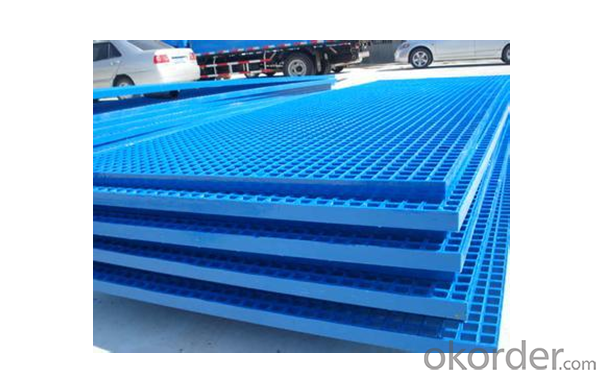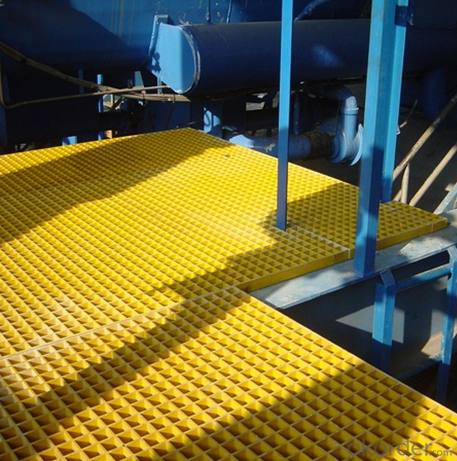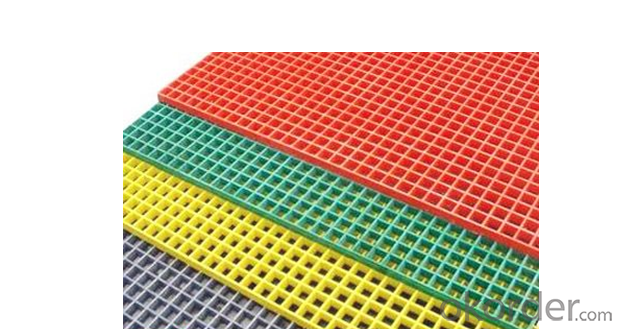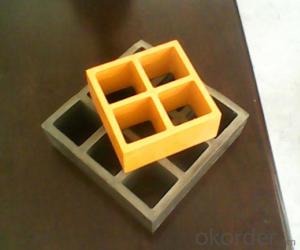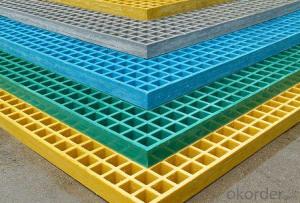FRP Grating for Walkway with Popular Color/Moder Type
- Loading Port:
- China main port
- Payment Terms:
- TT OR LC
- Min Order Qty:
- 100 m²
- Supply Capability:
- 500000 m²/month
OKorder Service Pledge
OKorder Financial Service
You Might Also Like
Introduction
FRP Molded Grating is a structural panel which uses high-strength E-Glass roving as reinforcing material, thermosetting resin as matrix and then casted and formed in a special metal mold. It provides properties of light weight, high strength, corrosion resistance, fire resistance and anti-skid. FRP Molded Grating is widely used in oil industry, power engineering, water & waste water treatment, ocean survey as working floor, stair tread, trench cover, etc. and is an ideal loading frame for corrosion circumstances.
Feature
l Corrosion Resistance
l Fire Resistance
l Light Weight & High Strength
l Safety & Anti-slip
l Electrical Insulating
l Aging Resistance
Specification
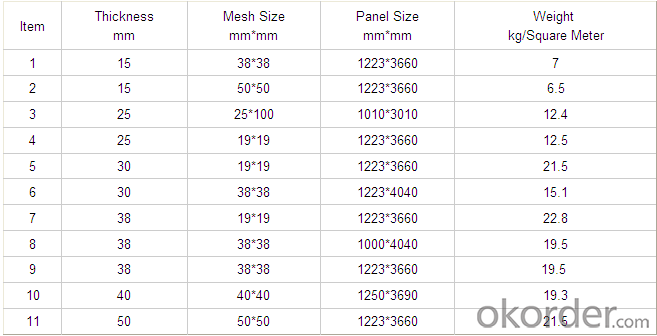
Advantage
1) coated with prevent aging layer
2) excellent insulating performance
3) no maintenance
4) high strength
5) long service life
6) easy installation
Application
l Power plants, substation equipment enclosures, antimagnetic, anti-static,to prevent small animals into the equipment failure, as there is electricity facilities and without power interval intervals.
l In high voltage electrical equipment for power line work, in order to prevent workers go wrong location, charged interval or near electrically charged equipment to dangerous distance.
l Pool railings in sewage treatment industry
l Corrosive chemical industry equipment around the fence
l All kinds of building maintenance section
FAQ
1. How about the documents after shipment?
After shipment, we ll send all original documents to you by DHL, including Packing List.Commercial Invoice, B/L, and other certificates as required by clients.
2. How long is the delivery time?
Usually it takes 10-25days after receipt of the deposits or L/C, and it also depends on the quantity of your order.
3. How's the payment?
Telegraphic Transfer(T/T) or Letter of Credit(L/C)
4. Do You Arrange Shipment?
Yes, dear esteemed customers, for FOB or CIF price, we will arrange shipment for you. For EXW price, clients need to arrange shipment by themselves or their agents.
5. How is the package?
Usually, we arrange the standard out-package for exporting.
PROCESS
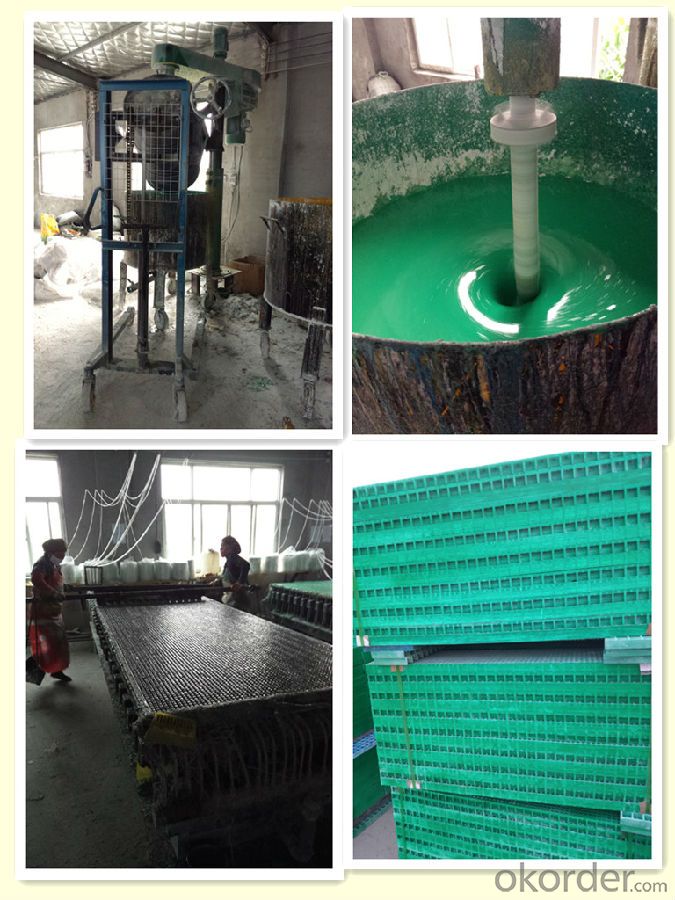
FACTORY

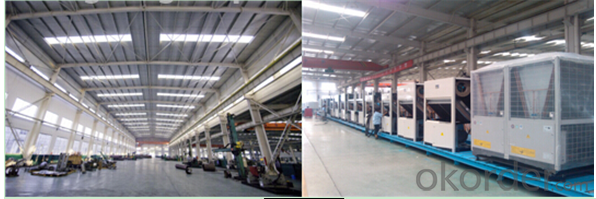
- Q:Do FRP pultrusion profiles require any special tools for installation?
- Installation of FRP pultrusion profiles necessitates the use of specialized tools. These profiles are manufactured through a continuous process wherein fibers are drawn through a resin bath and subsequently into a heated die, resulting in a material that is not only strong and lightweight but also resistant to corrosion. To ensure the proper installation of FRP pultrusion profiles, various specific tools are commonly employed. These tools encompass: 1. Cutting Tools: During installation, it may be necessary to cut FRP profiles to specific lengths. To achieve clean and precise cuts, specialized cutting tools like high-speed saws or abrasive wheels are frequently utilized. 2. Drilling Tools: For the insertion of fasteners or other fittings, it might be necessary to drill holes in FRP profiles. To prevent damage to the profile while creating these holes, special drill bits designed for working with composite materials are typically employed. 3. Fastening Tools: Depending on the application, it may be necessary to fasten FRP profiles to other surfaces or structures. Commonly used fasteners include stainless steel screws, bolts, or adhesives, which are specifically chosen for their ability to securely hold the profiles in place. 4. Joining Tools: In certain instances, it may be necessary to join FRP profiles together in order to create longer lengths or more intricate shapes. To ensure a robust and secure connection, special joining techniques such as bonding, riveting, or the use of mechanical connectors are employed. It should be noted that the specific tools required for installation may vary depending on factors such as the complexity and size of the project, as well as the recommendations provided by the manufacturer. Therefore, it is always advisable to consult the manufacturer's installation guidelines or seek professional assistance to ensure the proper installation and optimal performance of FRP pultrusion profiles.
- Q:FRP pultrusion process?
- Pultruded glass steel is mainly using unsaturated polyester resin, Yuezhanla extrusion molding process more than 90% in addition to the amount of resin, epoxy resin, vinyl resin, thermosetting resin, propionic acid modified phenolic resin, flame retardant resin etc..
- Q:The manufacturing process of FRP products?
- 1, hand paste production method; 2, spray forming method; 3, fiber winding process; 4, molding process and molding process; 5, pultrusion method.
- Q:Are FRP pultrusion profiles resistant to alkalis?
- Yes, FRP pultrusion profiles are generally resistant to alkalis.
- Q:Can FRP pultrusion profiles be used in oil and gas applications?
- Yes, FRP (Fiber Reinforced Polymer) pultrusion profiles can be used in oil and gas applications. FRP pultrusion profiles are known for their excellent corrosion resistance, high strength-to-weight ratio, and durability, making them suitable for various industries, including oil and gas. In oil and gas applications, FRP pultrusion profiles can be used for a wide range of purposes. They can be employed in the construction of pipelines, offshore platforms, and subsea structures. FRP profiles can also be used in the fabrication of tanks, vessels, and other equipment exposed to corrosive environments. One of the key advantages of FRP pultrusion profiles in oil and gas applications is their resistance to corrosion. Unlike traditional materials like steel, FRP does not rust or corrode when exposed to moisture, chemicals, or saltwater. This corrosion resistance extends the lifespan of the profiles and reduces maintenance costs. Additionally, FRP pultrusion profiles offer high strength and stiffness. They can withstand high pressures, extreme temperatures, and harsh operating conditions typically found in oil and gas environments. Their lightweight nature also makes them easier to handle and install compared to heavier materials like steel. Another benefit of FRP profiles is their non-conductive nature. This property makes them suitable for applications where electrical conductivity needs to be minimized, such as in offshore platforms or in areas with potential electrical hazards. Overall, FRP pultrusion profiles have proven to be a reliable and cost-effective solution for oil and gas applications. Their corrosion resistance, high strength, and lightweight properties make them ideal for various components and structures within the industry.
- Q:What are the load-bearing capabilities of FRP pultrusion profiles?
- FRP (Fiber Reinforced Polymer) pultrusion profiles have excellent load-bearing capabilities. The load-bearing capacity of FRP pultrusion profiles is determined by several factors such as the type and arrangement of fibers, resin properties, and the overall design of the profile. FRP pultrusion profiles are commonly used in various industries due to their high strength-to-weight ratio. The reinforcing fibers, typically made of materials such as fiberglass or carbon fiber, provide the profile with exceptional tensile and flexural strength. These fibers are embedded in a resin matrix, which further enhances the load-bearing capabilities of the profile. The load-bearing capacity of FRP pultrusion profiles can be tailored to meet specific requirements by adjusting the fiber type, orientation, and resin properties during the manufacturing process. This allows for a wide range of design possibilities and enables engineers to optimize the profiles for different applications. Furthermore, FRP pultrusion profiles exhibit excellent resistance to corrosion, making them suitable for use in harsh environments. Unlike traditional materials such as steel or wood, FRP profiles do not rust or rot, ensuring long-term durability and structural integrity. Overall, the load-bearing capabilities of FRP pultrusion profiles are highly impressive, making them a reliable choice for various load-bearing applications such as structural supports, bridges, platforms, and industrial equipment.
- Q:Are FRP pultrusion profiles resistant to moisture or humidity?
- Yes, FRP pultrusion profiles are highly resistant to moisture and humidity. The combination of fiberglass reinforcement and resin matrix used in their construction makes them non-corrosive and impervious to water absorption. This inherent resistance ensures their durability and performance in humid or moist environments without compromising their structural integrity.
- Q:Are FRP pultrusion profiles resistant to hail or impact damage?
- FRP pultrusion profiles exhibit exceptional resistance to both hail and impact damage. The incorporation of reinforcing fibers such as carbon or glass, along with a polymer resin matrix, grants these profiles unparalleled strength and durability. When compared to materials like wood, steel, or aluminum, FRP pultrusions offer significantly superior impact resistance. These profiles are specifically engineered to endure even the harshest environmental conditions, including hailstorms. The composite composition of FRP enables it to effectively absorb and distribute the energy generated by impacts, effectively preventing the formation of cracks or fractures. As a result, they are an ideal choice for various applications that necessitate protection against hail or impact damage, such as building facades, bridges, handrails, and utility poles. Moreover, FRP pultrusion profiles possess an impressive strength-to-weight ratio, meaning they can withstand heavy impacts without undermining their structural integrity. Furthermore, they are non-corrosive, making them impervious to rust or degradation caused by hail or impact. To summarize, the composite construction and exceptional strength-to-weight ratio of FRP pultrusion profiles render them highly resistant to hail or impact damage. They offer a reliable and long-lasting solution for applications that demand durability and resilience in the face of harsh environmental conditions.
- Q:Are FRP pultrusion profiles resistant to termites or other pests?
- Yes, FRP (Fiber Reinforced Polymer) pultrusion profiles are inherently resistant to termites and other pests. Unlike traditional wood or metal materials, FRP profiles do not provide a food source for termites or any other pests. FRP is composed of a combination of reinforced fibers and a polymer matrix, typically made of fiberglass and resin. These materials are not appealing to pests and do not provide any nutritional value, making FRP profiles highly resistant to termite damage or infestation. This resistance to pests is one of the many advantages of using FRP pultrusion profiles in various applications, especially in outdoor or humid environments where termites are commonly found.
- Q:Can FRP pultrusion profiles be used in walkway systems?
- Yes, FRP pultrusion profiles can be used in walkway systems. FRP pultrusion profiles are lightweight, strong, and resistant to corrosion, making them suitable for use in various applications, including walkways. They offer durability, low maintenance, and can withstand heavy loads, making them a reliable choice for walkway systems.
1. Manufacturer Overview |
|
|---|---|
| Location | |
| Year Established | |
| Annual Output Value | |
| Main Markets | |
| Company Certifications | |
2. Manufacturer Certificates |
|
|---|---|
| a) Certification Name | |
| Range | |
| Reference | |
| Validity Period | |
3. Manufacturer Capability |
|
|---|---|
| a)Trade Capacity | |
| Nearest Port | |
| Export Percentage | |
| No.of Employees in Trade Department | |
| Language Spoken: | |
| b)Factory Information | |
| Factory Size: | |
| No. of Production Lines | |
| Contract Manufacturing | |
| Product Price Range | |
Send your message to us
FRP Grating for Walkway with Popular Color/Moder Type
- Loading Port:
- China main port
- Payment Terms:
- TT OR LC
- Min Order Qty:
- 100 m²
- Supply Capability:
- 500000 m²/month
OKorder Service Pledge
OKorder Financial Service
Similar products
New products
Hot products
Hot Searches
Related keywords



